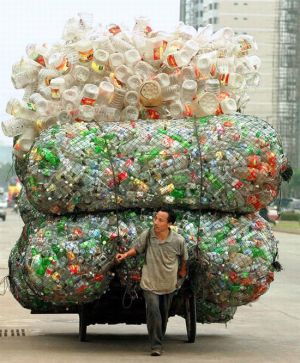 If we come to think of the possible uses of plastic in our everyday lives, the list would be endless. Name anything, from aircrafts to plates and saucers, almost every product uses plastic in some form or the other. Ever since manufacturers started manufacturing plastic in a large scale in the ’40s, its applications have increased manifold. Next year, 300 million of plastic will be produced worldwide. The usage of plastic is so wide that it has become an indispensable part of human life.
If we come to think of the possible uses of plastic in our everyday lives, the list would be endless. Name anything, from aircrafts to plates and saucers, almost every product uses plastic in some form or the other. Ever since manufacturers started manufacturing plastic in a large scale in the ’40s, its applications have increased manifold. Next year, 300 million of plastic will be produced worldwide. The usage of plastic is so wide that it has become an indispensable part of human life.
Boon or Bane?
This wonder invention has a dark side too. As its applications are increasing, so is the awareness about its ill effects. A step towards finding the harmful effects of plastic on human health and environment is a compilation of articles by authors from around the world. The compilation is first of its kind aiming to review the ill effects of plastic on environment and human health. This compilation has been published in this months issue of Philosophical Transactions of the Royal Society B. According to the report the plastic production in the first decade of the twenty first century will equal the entire production of the last century.
A red alert for environment
Disposable packaging in form of bottles and bags is the biggest culprit contributing towards environmental littering. The report says that more than 180 species of animals have been known to ingest plastic debris. Once in an animals stomach, it can poison it due to the chemicals that have accumulated into it. Barnes conducted a research in Amundsen sea ,the only sea without any research center on its coasts and has no urban centers around it for miles, and found plastic floating on its waters. Also, due to low temperatures of aquatic habitats, the longevity of plastic is increased. Algae and tubeworms cling to the plastic debris on the shores littering the ice. The composition of plastic is resistant to decay to an extent that even burying it doesn’t impede its harmful effects and it ultimately finds its way into groundwater.
How it affects the human health?
Plastic is harmful to human health as well because chemical added in plastics are ultimately absorbed by the human body altering the hormones. Humans are exposed to chemicals of plastics via air, water, dust, food and consumer products. Phthalates, used as plasticizers in wall coverings, vinyl flooring, food packaging and medical devices, finds its way into the human body. Besides, bisphenol A (BPA) is also reported to have found its way into drinks and food through polycarbonate bottles and food and beverage can linings. Polybrominated diphenyl ethers (PBDE’s), added to foam furniture cushions, mattresses are found to be harmful. Despite studies revealing a relation between plastic and heart diseases, reproductive abnormalities, diabetes and brain development, scientists reiterate the need for more sophisticated studies in these areas.
A stitch in time…
Scientists stress on focusing on plastic’s reusability instead of promoting it as a disposable commodity meant to be discarded. The idea is to make it more easily recyclable and reducing its manufacturing. Both industry and society needs to see it as a raw material rather than waste. A very good option is making biodegradable plastic made out of soy and corn more available. As of now, biodegradable plastic accounts for only 0.2 percent of the total plastic production the world over. Scientists are also apprehensive about the total degradability of these biodegradable plastics. The report emphasizes the use of safer alternatives to plastic. This initiative is known as Green Chemistry.
Consumers’ responsibility
The report also stresses on making the end consumer aware of the chemical content of plastic products so that they can differentiate between what is harmful and what isn’t. Since most consumer would never go for environmentally harmful products , providing them facts about the products contents would go a long way in ushering in a paradigm shift and the acceptance of plastic in our day to day lives. The authors say that ‘if plastics are made and used responsibly, they can help solve some environmental problems’. Thus legislation alone is not the answer, the responsibility also lies with the consumers.
Image Credit
Via: Scientific American




